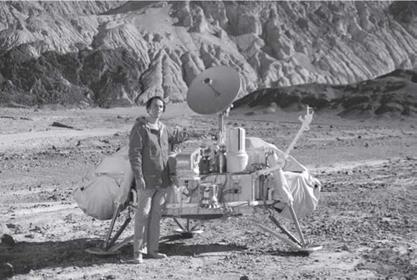Gaia Theory and Earth System Science
Together Lovelock and Margulis theorized that Earth’s habitability was not simply a function of its orbital position relative to the Sun, but was in large part due to biota metabolizing and cycling atmospheric gases and rock minerals. As Margulis explained, “The metabolism, growth, and multiple interactions of the biota modulate
|
Figure 2.4. Carl Sagan poses with a model of the Viking lander in Death Valley, California. Sagan was a pivotal figure in the mission planning, leading the argument to include a camera in the design. His research pointed to the intimate connection between the composition of a planetary atmosphere and its habitability (NASA/Jet Propulsion Laboratory). |
the temperature, acidity, alkalinity, and, with respect to chemically reactive gases, atmospheric composition at the Earth’s surface.”63 While Lovelock considered the impact of all forms of life in using and maintaining Earth’s biosphere, Margulis’s contribution to Gaia in the early 1970s highlighted the shaping effect of microorganisms relative to atmospheric chemistry, rock weathering, and carbon deposition via phytoplankton onto the seafloor. Lovelock wrote: “Lynn brought her deep understanding of microbiology to what until then had been mainly a system science theory that saw a self-regulating Earth through the eyes of a physical chemist. By stressing the importance of the Earth’s bacterial ecosystem and its being the fundamental infrastructure of the planet, Lynn put flesh on the skeleton of Gaia.”64
However, in the early 1970s, when Lovelock and Margulis floated their ideas regarding Gaia, Earth sciences were largely studied in isolation. “Oxygen, for example, was thought to come solely from the breakdown of water vapour and the escape of hydrogen into space, leaving an excess of oxygen behind,” explains
Lovelock. “Life merely borrowed gases from the atmosphere and returned them unchanged. Our contrasting view required an atmosphere which was a dynamic extension of the biosphere itself.”65 It’s not surprising that the Gaia hypothesis was initially controversial and slow to be accepted. By 1974, Lovelock and Margulis were publishing scientific papers on Gaia. However, they also published a paper for nonspecialists titled “The Atmosphere, Gaia’s Circulatory System” in Stewart Brand’s CoEvolution Quarterly.66 New Age connotations and the fact that the theory was championed by many nonscientists didn’t help their cause. Another issue was the sheer complexity of the biosphere and its interlocking parts—scientists had trouble making robust and predictive models of its behavior.67 But contrary to the scientific community’s cool reception of the Gaia hypothesis, NASA was very interested in Lovelock’s ideas regarding planetary atmospheres.
Gaia Theory proposes that bacteria and other organisms not only consume and replenish atmospheric components like oxygen and methane but also maintain our biosphere’s temperature and habitability through rock weathering and the cycling of carbon, oxygen, sulfur, and other chemicals. The atmosphere is understood as a coupled system with the lithosphere, hydrosphere, and the planet’s biota, and these geospheres interact in cycling water, minerals, chemicals, and atmospheric gases. The theory, however, evolved over time and represented a spectrum of ideas. At one end of the spectrum was the uncontroversial premise that living organisms have altered Earth’s atmosphere and surface geology. Following from that is the idea that the biosphere and the Earth co-evolve in a way that is self-regulatory due to negative feedback loops. The most extreme form of the theory, containing the idea that the entire biosphere is somehow a living organism, with the teleological implication that the continuation of life is a purpose of co-evolution, has been discredited (and Lovelock was always clear about not subscribing to these views). Nor were Lovelock and Margulis the first to consider Earth’s biology and its geospheres as intimately coupled. Early proponents of such thinking were the eighteenth – century Scottish geologist James Hutton, the father of modern geology, and the Russian mineralogist Vladimir Vernadsky. Hutton was among the first to theorize how rock cycling impacted our entire planet, referring to the Earth as a “superorganism,” while Vernadsky theorized in the early twentieth century that geologic processes contributed to sustaining the biosphere.68
Lovelock and Margulis’s integrated view supposed that microorganisms not only maintained Earth’s habitable atmosphere and climate, but also could alter the environment on a planetary scale. For this and reasons noted above, Gaia hypothesis seemed preposterous to many people. However, as Lovelock explains in The Vanishing Face of Gaia (2009), “It is too often wrongly assumed that life has simply adapted to the material environment, whatever it was at the time; in reality life is much more enterprising. When confronted with an unfavorable environment it can adapt, but if that is not sufficient to achieve stability it can also change the environment.”69 Stromatolites in Australia’s Shark Bay indicate, for example, that by 2.4 billion years ago the progenitors of cyanobacteria developed oxygenic photosynthesis and began to reconfigure the Earth’s early atmosphere from largely nitrogen and carbon dioxide to the nitrogen – and oxygen-rich composition we breathe today. But any correlation between the emergence of oxygen metabolizing life and global atmospheric composition is complex. Measurable levels of oxygen appeared 300 million to a billion years after the first evidence of oxygenic photosynthesis, which indicates other geologic or hydrologic processes were simultaneously stripping oxygen from the atmosphere.70 The complexity of how microorganisms and geochemical processes combine to sustain or alter our atmosphere remains at the core of Gaia Theory and Earth System Science.











